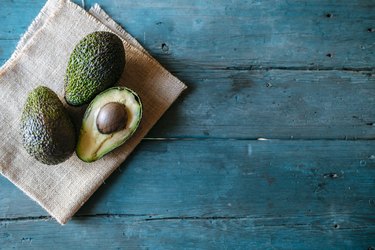
An avocado that's brown on the outside and slightly soft to the touch means it's spot-on ripe, but if it's brown inside, you may have an overripe fruit. Moldy odors and dark patches, on the other hand, are often signs of a rotten avocado. In this case, the fruit may not be safe to eat.
Tip
If you have an avocado that shows signs of mold, such as deep brown spots, spores and musty or moldy odors, discard the fruit immediately.
Video of the Day
Ripe to Overripe Avocados
When an avocado's skin appears thin and changes its color to dark brown, the fruit inside — known as the mesocarp — is ready to eat. If there are stripes or dark rooty lines in your avocado, it might be infected by a parasite or fungus, notes the University of California.
Video of the Day
A fruit that feels quite soft and leaves an indentation when you squeeze it is likely overripe. It may still be OK for mashing into guacamole or a sandwich spread. Brown lesions or stripes, on the other hand, might indicate a fungus or rot. Usually, this is detected at harvest, explains Texas A&M University.
If you've stored a cut avocado in the fridge for a few hours or overnight, it may turn brown due to natural enzymatic activity. The brown tissue isn't dangerous to eat but can be unappetizing and ruin the look of your bright green guacamole. Researchers note in a December 2017 issue of Critical Reviews in Food Science and Nutrition that they're looking at a way to curb this oxidation but have yet to be successful. You may minimize browning by squeezing lemon or lime juice over the fruit after cutting it.
An avocado that has been cut is also susceptible to mold if left in the fridge for too long. Molds do prefer warm environments but can grow in the refrigerator too, points out the USDA.
In a soft fruit like avocados, the mold can penetrate below the surface of the skin. If you see signs of mold, just get rid of the whole fruit.
Are Unripe Avocados Edible?
If you have the opposite problem — your fruit is rock-hard and bright green — it isn't ready for eating. It won't slice easily or mash into a smooth dip. The flavor will also be off. Speed up the ripening process by taking advantage of the same enzyme activity that browns cut avocados quickly. As explained by the University of Maine, most fruits produce ethylene gas, which starts the ripening process.
Although many recipes use avocado just like a vegetable, this is actually a berry — explains Texas A&M University. You can speed up an avocado's ripening by exposing it to ethylene from other fruits, so store unripe ones next to bananas, pears, or peaches. You may even put these fruits together in a brown paper bag. Your avocado will be ripe within a few days. This may not be as quickly as you'd like, but it will guarantee you have a flavorful fruit that's just right for your recipe.
Read more: Avocado Pizza
Eat Avocados for Your Health
Don't shy away from these nutritious fruits because you're afraid of overripe avocados. An average avocado provides 227 calories and 21 grams of fat, according to the USDA. But the nutrients it supplies are worth the extra calories. Only 3 grams of this fat is the unhealthy saturated type. The rest consists of health-supporting unsaturated fats.
Avocados are particularly rich in monounsaturated fats that may help improve your cholesterol ratio. When consumed regularly, they may raise the levels of good, or HDL, cholesterol in your system. An improved ratio of HDL to LDL cholesterol may lower your risk of heart disease and strokes.
This fruit has about 9 grams of fiber, which ensures good digestion. It's also an excellent source of potassium, folate, and vitamins E, B6 and C, reports the Academy of Nutrition and Dietetics. Include nutritious avocados as part of a salad, on top of tacos or chili or inside of a sandwich. Use them to replace less healthy fat-containing condiments, like cheese, sour cream and mayonnaise. Try this Hass Avocado and Edamame Tartine from LIVESTRONG.com!
- University of Maine: "The Role of Ethylene in Fruit Ripening"
- USDA: "Molds on Food"
- Critical Reviews in Food Science and Nutrition: "Enzymatic Browning in avocado (Persea americana) Revisited: History, Advances, and Future Perspectives"
- Purdue University: "Avocado"
- Food Data Central: "Avocado, California"
- Academy of Nutrition and Dietetics: "Choose Healthy Fats"
- Texas A&M University: "Avocados"
- University of California: "Avocados"
- Mayo Clinic: "Dietary Fats: Know Which Types to Choose"
- Oregon Live: No Matter How You Slice Them, Avocados are Good for Much More than Guacamole